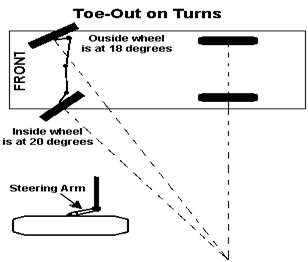SKEDSOFT
Introduction:
Toe-out can be found in at least one of five main forms; static toe out, toe out on turns "Ackerman steering", toe out due to bump steer, steering arm toe out, and toe out due to slip angles.
Toe-out defined:
Toe-out exists when the tires are closer together in the rear than in the front and excessive toe out results in the feather wear.

- When we steer a car through a turn, the outside front wheel has to navigate a wider arc then the inside wheel. For this reason, the inside front wheel must steer at a sharper angle than the outside wheel.
- Toe-out on turns is measured by the turning angle gauges (turn plates) that are a part of every wheel alignment machine. The readings are either directly on the turn plate or they are measured electronically and displayed on the screen.
- Wheel alignment specifications will usually provide the measurements for toe-out on turns. They will give an angle for the inside wheel and the outside wheel such as 20º for the inside wheel and 18º for the outside wheel.
- The readings are at zero on each side when the wheels are straight ahead, then turn the steering wheel so that the inside wheel is at the inside spec. then check the outside wheel.
- The toe-out angles are accomplished by the angle of the steering arm. This arm allows the inside wheel to turn sharper than the outside wheel.
- The steering arm is either part of the steering knuckle or part of the ball joint and is not adjustable. If there is a problem with the toe-out, it is due to a bent steering arm that must be replaced.
